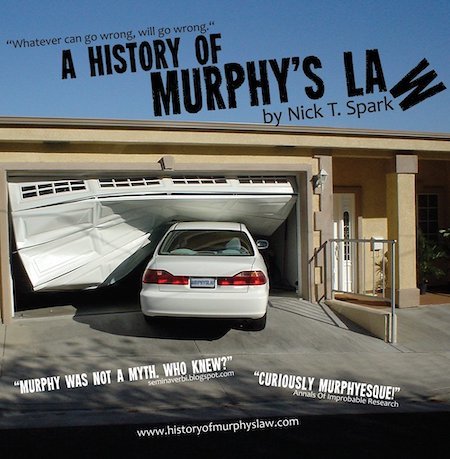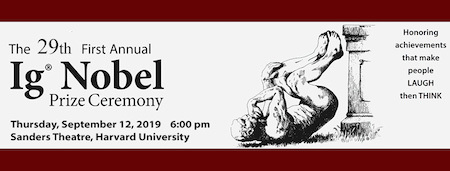Marc Abrahams's Blog, page 140
August 14, 2019
Smell and Laugh, Tickled Rats
This study tells of a new (and perhaps the first) advance in the effort to explore the relationship between rats and laughter and odor:
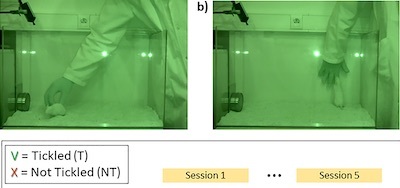
“Odour Conditioning of Positive Affective States: Rats Can Learn to Associate an Odour with Being Tickled,” Vincent Bombail, Nathalie Jerôme, Ho Lam, Sacha Muszlak, Simone L. Meddle, Alistair B. Lawrence, and Birte L. Nielsen, PLoS ONE, vol. 4, no. 6, 2019: e0212829.
The authors report: “This work is the first to test in a fully balanced design whether rats can learn to associate an odour with tickling.”
The report does not specify whether this effect also happens in mice.
The University of Edinburgh produced a press release about the rat work.

August 13, 2019
A nice appreciation (what could go wrong?) of Murphy and Stapp
The Today I Found Out blog has a nice appreciation of two—really three—people who shared an Ig Nobel Prize for (probably) giving Murphy’s Law it’s name. The appreciation is called “WHO WAS ‘MURPHY’ IN ‘MURPHY’S LAW’ AND THE AMAZING DR. JOHN PAUL STAPP WHO GAVE US THE EXPRESSION.”
The 2003 Ig Nobel Prize for engineering was awarded to the late John Paul Stapp, the late Edward A. Murphy, Jr., and George Nichols, for jointly giving birth in 1949 to Murphy’s Law, the basic engineering principle that “If there are two or more ways to do something, and one of those ways can result in a catastrophe, someone will do it “(or, in other words: “If anything can go wrong, it will”).
By pretty much all accounts, John Stapp was the central figure. That’s him, undergoing extreme decelleration in a rocket-powered sled, in this series of photos:
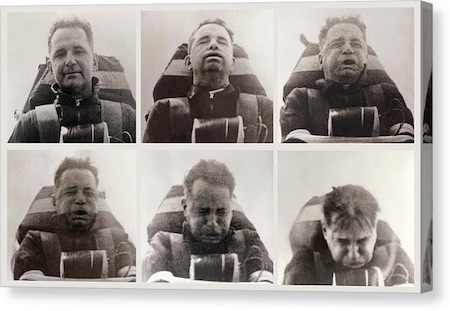
At the Ig Nobel Prize ceremony at Harvard University, the prize presentation involved: Author Nick T. Spark , on behalf of John Paul Stapp’s widow, Lilly; (2) Edward Murphy’s Edward A. Murphy III, on behalf of his late father; and (3) George Nichols, via audio tape. You can watch video of that historic happening.
For a deep and fun exploration of the history (and slight mystery, still) behind that, see “The Fastest Man on Earth,” Nick T. Spark, Annals of Improbable Research, vol. 9, no. 5, Sept/Oct 2003. Spark expanded that long article into a delightful book called A History of Murphy’s Law.
Here’s a US Air Force documentary film about some of John Stapp’s work:

August 12, 2019
One month from today: The 29th First Annual Ig Nobel Prize ceremony
The 29th First Annual Ig Nobel Prize ceremony will happen one month from today—on Thursday, September 12, 2019—at Sanders Theatre, Harvard University.
Some (but not a lot of) TICKETS are still available from the Harvard Box Office.
Ten new Ig Nobel Prize winners will be revealed. Their prizes will be handed to them by a gaggle of bemused Nobel laureates.
The theme of this year’s ceremony (though not necessarily of the things that win prizes) is HABITS. The ceremony will include the premiere of the mini-opera “Creatures of Habit,” about a visit to the (fictional, alas) Museum of Bad Habits.
The ceremony will be webcast live, as it has been every year since 1995. (Webcasting was more or less invented for that year’s ceremony. Our broadcast engineer in the early years was none other than Robert T. Morris).

Associations: Terrorist attacks and CEOs’ wages [new study]
“This is an important topic”
– say Yunhao Dai, Raghavendra Rau, Aris Stouraitis and Weiqiang Tan [jointly of the Huazhong University of Science and Technology, China; Cambridge Judge Business School, University of Cambridge, UK; and the Hong Kong Baptist University, Hong Kong]. The important topic to which they are referring is the question of whether CEOs (Chief Executive Officers) of major US companies might tend to be rewarded with cash-based compensations (e.g. increased salary and bonuses etc.) in the unfortunate event that a terrorist attack happens within 100 miles or so of their office.
According to the results of the team’s research project, they do indeed :
“We show that CEOs employed at firms located near terrorist attacks earn an average pay increase of 12% after the attack relative to CEOs at firms located far from attacks.”
See: ‘An ill wind? Terrorist attacks and CEO compensation’ in press at the Journal of Financial Economics, June, 2019.
The study notes that:
“Other executives and workers do not receive a terrorist attack premium.”
Co-author Rao shared the 2015 Ig Nobel Prize for management with several colleagues, for for discovering that many business leaders developed during childhood a fondness for risk-taking, when they experienced natural disasters (such as earthquakes, volcanic eruptions, tsunamis, and wildfires) that — for them — had no dire personal consequences.
Research research by Martin Gardiner

August 9, 2019
Baseball mud deglossing machine: A Quixotic quest?
“This application claims benefit of U.S. Provisional Application No. 61/066,848, entitled ‘Baseball Deglosser Machine For Mudding a Baseball‘ and filed on Feb. 22, 2008, which is specifically incorporated herein by reference for all that it discloses and teaches,” says US patent application US 2009/0214792 A1, filed in 2009.
The application describes a machine that attempts to replace, mechanically, the traditional rubbing of special (and single-sourced) mud on major league baseballs.
The mud and its history get star billing in Emma Baccillieri’s article “Mud Maker: The Man Behind MLB’s Essential Secret Sauce,” published in Sports Illustrated. (Thanks to Mark Dionne for bringing it to our attention.)
Here’s a little video documentary on baseball mud rubbing:

August 8, 2019
Flavouring fruity booze with a stinky gas [patent]
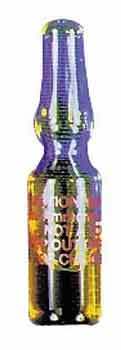 If you’re trying to make an alcoholic drink with the flavour of passion fruit and grapefruit, an obvious method would be to ferment passion fruit and grapefruit juices. But that’s not the only way. You could, for example, get hold of a fermenting New Zealand Sauvingnon Blanc as a base, and then bubble hydrogen sulfide (H2S) though it. If you’re not familiar with hydrogen sulfide [that’s hydrogen sulphide in the UK] here’s what Wikipedia’s entry says about it:
If you’re trying to make an alcoholic drink with the flavour of passion fruit and grapefruit, an obvious method would be to ferment passion fruit and grapefruit juices. But that’s not the only way. You could, for example, get hold of a fermenting New Zealand Sauvingnon Blanc as a base, and then bubble hydrogen sulfide (H2S) though it. If you’re not familiar with hydrogen sulfide [that’s hydrogen sulphide in the UK] here’s what Wikipedia’s entry says about it:
“Hydrogen sulfide is the chemical compound with the formula H2S. It is a colorless chalcogen hydride gas with the characteristic foul odor of rotten eggs. It is very poisonous, corrosive, and flammable.”
A less-than-ideal chemical, you might think, to use in flavouring alcoholic drinks. Nevertheless, a 2014 US patent from the drinks makers Pernod-Ricard suggests that bubbling H2S though a fermenting grape juice / wine – particularly Sauvingnon Blanc from New Zealand – might be a good way of producing a drink with the flavour of passion fruit and grapefruit.
“It is an object of the present invention to provide a useful alternative for producing an alcoholic beverage having a fruity flavor, in particular being reminiscent of grapefruit and passion fruit, which is easily carried out and which provides a better control of the level of the aromas in the obtained alcoholic beverage than other known methods of producing alcoholic beverages.”
“The inventors have surprisingly found, that due to the bubbling of a gas stream containing hydrogen sulfide into grape juice, the volatile thiol content of 3MH and 3MHA in the finished wine had been increased, in some cases tripled, in relation to the volatile thiol content of wine derived from the same grapes obtained by standard methods without bubbling.”
See: Method of producing an alcoholic beverage having a fruity flavor, 9758752 Sep. 12 2017
Note: The image depicts an historic ‘stink bomb’ – which were sometimes based on H2S in solution.

August 7, 2019
PhD Fellowship in Meal Detection by Analysis of Bowel Sounds
On March 14, 2019, the Norwegian University of Science and Technology (NTNU) posted this ad:
PhD Fellowship in Meal Detection by Analysis of Bowel Sounds
We have a vacancy for a PhD fellowship within analysis of bowel sounds for meal detection in diabetes patients at the Department of Engineering Cybernetics (ITK), Faculty of Information Technology and Electrical Engineering at the Norwegian University of Science and Technology (NTNU). The position is affiliated with the Artificial Pancreas Trondheim (APT) research group….
Job description—This PhD project aims to analyse recorded sounds from the upper body (mostly targeted at the intestines/bowel) in order to detect meals in patients with diabetes….
Applicants are required to justify their candidacy by explicitly explaining their personal motivation and academic aptitude for pursuing a doctoral degree within this research field.
The time for this has, however, passed. The ad now bears the advisory: “This job is no longer available.”
(Thanks to John Culvenor for bringing this to our attention.)

August 6, 2019
Prize-winning underwear that traps bad smells
Innovative Scientists Talk About Their Childhood (14): Nicole Sharp hating math class
Here’s Nicole Sharp talking about what happened when she hated math class when she was a child. What happened excited Nicole in a way that led to her eventual unusual career. Nicole created and runs FYFD, the most popular fluid dynamics web site in this part of the universe.
ABOUT THIS LITTLE VIDEO SERIES—This is part of a series of sessions we (David Hu and I, and a film crew) recorded at Georgia Tech. We assembled a little group of scientists (including David) who are renowned for looking at questions others might overlook, and doing research in inventive, clever ways.
The question we asked them: “What happened when you were a kid that somehow led—much later—to your doing unusual science?”
The scientists: David Hu, Suzana Herculano-Houzel, Frans de Waal, Nicole Sharp, Diego Golombek, and Olga Shishkov. Follow the links on their names to begin exploring some of their work!

August 5, 2019
Should researchers refrain from eating their research subjects? [study]
If you are a researcher studying, say, concrete bridge structures, or microprocessors, then you probably wouldn’t have to be overly concerned about potential criticism from peers regarding the possibility that you might eat your research subjects. But this is not the case for all academic fields. Take for example, ‘Animal Studies’.
A 2018 paper published in the Animal Studies Journal (ASJ) asks : Should We Eat Our Research Subjects? Advocacy and Animal Studies , ASJ, 7(1), pp.180-205.
“The decision by Animal Studies scholars whether or not to eat their research subjects is, as our survey shows, an indicator of the extent to which Animal Studies scholars are willing to fundamentally challenge established norms, and whether they wish to stringently advance the wellbeing of nonhuman animals.
It is clear that the majority of Animal Studies scholars surveyed believe that the field has an important role to play in advocating for animals. Most of the respondents base their research on a personal interest in and commitment to animal wellbeing and for scholars who identify as vegan this also comes with an added prior commitment to animal advocacy, that in turn appears to shape their expectations for what the field should aim to achieve. However the data also shows that there remains a reluctance by many Animal Studies academics to fully engage with the consequences of human exceptionalism, which is demonstrated by the large number of respondents who still eat meat and other animal products. “
Bonus Assignment [optional] Can you suggest any other academic fields where eating the research subjects might be a contentious issue?
Research research by Martin Gardiner

Marc Abrahams's Blog
- Marc Abrahams's profile
- 14 followers


